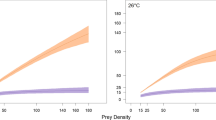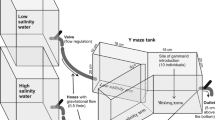Abstract
Bioinvasions by closely related species often lead to niche competition between exotic and indigenous species. The outcome of this competition is partly determined by differences in physiological tolerance of the competing species to the environmental conditions of the colonised habitat. Physiological tolerance of the invading gammarid species Gammarus tigrinus, Echinogammarus ischnus and Dikerogammarus villosus and the indigenous gammarid species Gammarus pulex, Gammarus roeseli and Gammarus fossarum from Dutch waters was studied in the laboratory by comparing their pleopod beats at rest at different water temperatures, which reflect the gammarid's oxygen consumption. Pleopod beat frequencies increased from a minimum ventilatory activity of 0 beats per minute at 1 °C to maximum activity of up to 300 beats per minute at temperatures between 25 °C and 35 °C. At the state of maximum activity, a further increase in temperature was followed by a strong decrease in pleopod beat frequency, indicating acute stress, and subsequently mortality. Frequency response patterns of invading and indigenous gammarids were found to be highly similar, indicating a wide tolerance to temperature for all species. The tolerance of D. villosus, however, was reduced in brook water, indicating a lower competitive ability in relatively ion-poor water. G. tigrinus survived at higher temperatures in the more ion-rich, polluted waters than the indigenous gammarids, indicating a wider physiological tolerance and thus a higher competitive ability in these waters.
Similar content being viewed by others
References
Bij de Vaate A. and Klink A.G. 1995. Dikerogammarus villosus Sówinsky (Crustacea: Gammaridae) a new immigrant in the Dutch part of the Lower Rhine. Lauterbornia 20: 5–54.
Bij de Vaate A., Jazdzewski K., Ketelaars H.A.M., Gollasch S. and van der Velde G. 2002. Geographical patterns in range extension of Ponto-Caspian macroinvertebrate species in Europe. Can J. Fish. Aquat. Sci. 59: 115–1174.
Bruijs M.C.M., Kelleher B., Van der Velde G. and Bij de Vaate A. 2001. Oxygen consumption, temperature and salinity tolerance of the invasive amphipod Dikerogammarus villosus: indicators of further dispersal via ballast water transport. Arch. Hydrobiol. 152: 63–646.
Cáceres C.E. 1998. Seasonal dynamics and interspecific competition in Oneida Lake Daphnia. Oecologia 115: 23–244.
Dick J.T.A., Montgomery I. and Elwood R.W. 1993. Replacement of the indigenous amphipod Gammarus duebeni celticus by the introduced G. pulex: differential cannibalism and mutual predation. J. Anim. Ecol. 62: 7–88.
Dick J.T.A. and Platvoet D. 1996. Intraguild predation and species exclusions in amphipods: the interaction of behaviour, physiology and environment. Freshw. Biol. 36: 37–383.
Dick J.T.A. 1996. Post-invasion amphipod communities of Lough Neagh, Northern Ireland: influences of habitat selection and mutual predation. J. Anim. Ecol. 65: 75–767.
Dick J.T.A. and Platvoet D. 2000. Invading predatory crustacean Dikerogammarus villosus eliminates both native and exotic species. Proc. R. Soc. Lond., B 267: 97–983.
Dorgelo J. 1973. Comparative ecophysiology of gammarids (Crustacea: Amphipoda) from marine, brackish and fresh-water habitats exposed to the influence of salinity-temperature combinations. III. Oxygen uptake. Neth. J. Sea Res. 7: 25–266.
Franke U. 1977. Experimental investigations of the respiration of Gammarus fossarum Koch 1835 (Crustacea-Amphipoda) in relation to temperature, oxygen concentration and water movement. Arch. Hydrobiol. Suppl. 48: 36–411.
Gerhardt A. 1995. Monitoring behavioural responses to metals in Gammarus pulex (L.) (Crustacea) with impedance conversion. Environ. Sci. & Pollut. Res. 2: 1–23.
Hargeby A. and Petersen R.C. 1988. Effects of lower pH and humus on the survivorship, growth and feeding of Gammarus pulex (L.) (Amphipoda). Freshw. Biol. 19: 23–247.
Harris R.R. and Muskó I.B. 1999. Oxygen consumption, hypoxia, and tube-dwelling in the invasive amphipod Corophium curvispinum. J. Crust. Biol. 19: 22–234.
Hervant F., Freminet A. and Mathieu J. 1995. Ventilatory activity and locomotory behaviour in anoxia and subsequent recovery of epigean and hypogean crustaceans: preliminary results. Mém. Biospéol. 22: 5–56.
Hervant F., Mathieu J. and Culver D.C. 1999. Comparative responses to severe hypoxia and subsequent recovery in closely related amphipod populations (Gammarus minus) from cave and surface habitats. Hydrobiol. 392: 19–204.
Kahlert J. and Neumann D. 1994. Die automatische Erfassung der Ventilationsrhythmik von Gammariden; Methode und erste Ergebnisse. Erweiterte Zusammenfassungen der Jahrestagung 1994. Deutsche Gesellschaft für Limnologie.
Lawrence A. and Poulter C. 1996. The potential role of the estuarine amphipod Gammarus duebeni in sub-lethal ecotoxicology testing. Wat. Sci. Tech. 34: 9–100.
Leentvaar P. 1955. Biologisch evenwicht. De Levende Natuur. 58: 3–36.
MacNeil C., Dick J.T.A. and Elwood R. 2000. Differential physicochemical tolerances of amphipod species revealed by field transplantations. Oecologia 124: –7.
Moyle P.B. and Light T. 1996. Fish invasions in California: Do abiotic factors determine success? Ecology 77: 166–1670.
Pinkster S., Smit H. and Brandse-de Jong N. 1977. The introduction of the alien amphipod Gammarus tigrinus Sexton, 1939, in the Netherlands and its competition with indigenous species. Crustaceana Suppl. 4: 9–105.
Pinkster S. and Platvoet D. 1983. Further observations on the distribution and biology of two alien amphipods, Gammarus tigrinus Sexton, 1939, and Crangonyx pseudogracilis Bousfield, 1958, in the Netherlands (Crustacea, Amphipoda). Bull. Zool. Mus. Univ. Amsterdam 9: 15–164.
Platvoet D. and Pinkster S. 1995. Changes in the amphipod fauna (Crustacea) of the Rhine, Meuse and Scheldt estuary due to the‘ Delta plan’ coastal engineering works. Neth. J. Aquat. Ecol. 29: –30.
Pöckl M. 1995. Laboratory studies on growth, feeding, moulting and mortality in the freshwater amphipods Gammarus fossarum and G. roeseli. Arch. Hydrobiol. 134: 22–253.
Ricciardi A. and Rasmussen J.B. 1998. Predicting the identity and impact of future biological invaders: a priority for aquatic resource management. Can J. Fish. Aquat. Sci. 55: 175–1765.
Savage A.A. 1982. The survival and growth of Gammarus tigrinus Sexton (Crustacea: Amphipoda) in relation to salinity and temperature. Hydrobiol. 94: 20–212.
Sutcliffe D.W. 1984. Quantitative aspects of oxygen uptake by Gammarus (Crustacea, Amphipoda): a critical review. Freshw. Biol. 14: 44–489.
Ter Braak C.J.F. and Smilauer P. 1998. Reference manual and user's guide to Canoco for Windows: Software for canonical community ordination (version 4). Microcomputer Power, Ithaca, New York, USA.
Van den Brink F.W.B., Paffen B.G.P., Oosterbroek F.M.J. and Van der Velde G. 1993. Immigration of Echinogammarus (Stebbing, 1899) (Crustacea: Amphipoda) into the Netherlands via the lower Rhine. Bull. Zool. Mus. Univ. Amsterdam 13: 16–169.
Van der Velde G., Rajagopal S., Kelleher B., Muskó I.B. and Bij de Vaate A. 2000. Ecological impact of crustacean invaders: general considerations and examples from the Rhine River. Crustacean Issues 12: –33.
Van der Velde G., Nagelkerken I., Rajagopal S. and Bij de Vaate A. 2002. Invasions by alien species in inland freshwater bodies in Western Europe: The Rhine delta. In: Leppäkoski E., Gollash S. and Olenin S. (eds), Invasive Aquatic Species of Europe. Distribution, Impacts and Management. Kluwer Academic Publishers, Dordrecht, The Netherlands, pp. 36–372.
Williamson M. and Fitter A. 1996. The varying success of invaders. Ecology 77: 166–1666.
Author information
Authors and Affiliations
Corresponding author
Rights and permissions
About this article
Cite this article
Wijnhoven, S., van Riel, M. & van der Velde, G. Exotic and indigenous freshwater gammarid species: physiological tolerance to water temperature in relation to ionic content of the water. Aquatic Ecology 37, 151–158 (2003). https://doi.org/10.1023/A:1023982200529
Issue Date:
DOI: https://doi.org/10.1023/A:1023982200529




